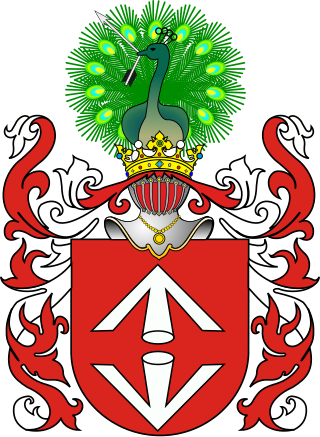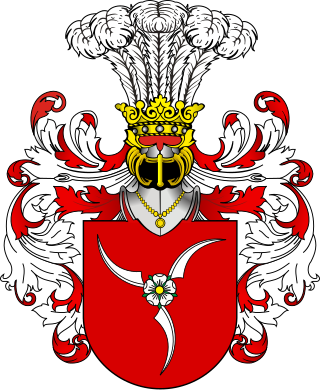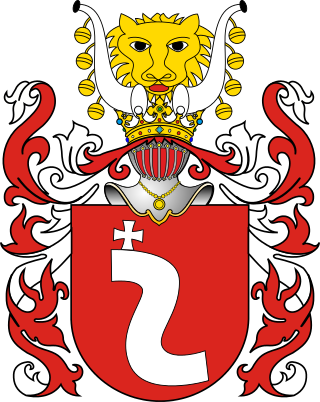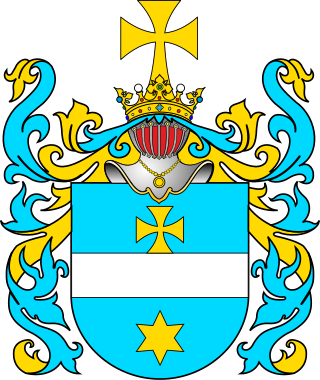Hozyusz is a Polish coat of arms. It was used by several szlachta families.
Hozyusz is a Polish coat of arms. It was used by several szlachta families.
| | This section is empty. You can help by adding to it. (July 2010) |
| | This section is empty. You can help by adding to it. (July 2010) |
Notable bearers of this coat of arms include:

Nałęcz is a Polish coat of arms. It was used by associated szlachta families in the Kingdom of Poland and the Polish–Lithuanian Commonwealth (1569–1795).

Lis is a Polish coat of arms. It was used by many noble families of Clan Lis.

Ciołek is a Polish coat of arms, one of the oldest in medieval Poland. It was used by many szlachta (noble) families under the late Piast dynasty, under the Polish–Lithuanian Commonwealth, during the Partitions of Poland, and in the 20th century. The variant names "Siolek" and "Cialek" arose from miscommunication among early-20th-century Polish immigrants to the United States.

Bogoria is a Polish coat of arms. It was used by several szlachta families in medieval Poland and later under the Polish–Lithuanian Commonwealth, branches of the original medieval Bogoriowie family as well as families connected with the Clan by adoption.

Rola is a Polish coat of arms. It was used by several szlachta families in the times of the Kingdom of Poland and Polish–Lithuanian Commonwealth.

Topór is a Polish coat of arms. It was used by several szlachta (noble) families in medieval Poland and under the Polish–Lithuanian Commonwealth.

Srzeniawa is a Polish coat of arms. It was used by several szlachta families in the times of the Kingdom of Poland and the Polish–Lithuanian Commonwealth.

Giejsz is a Polish coat of arms. It was used by several szlachta families.

Alabanda is a Polish nobility coat of arms, used by several szlachta families in the times of the Kingdom of Poland.

Bończa is a Polish coat of arms.

Bojcza is a Polish coat of arms. It was used by several szlachta families.

Wieniawa is a Polish coat of arms. It was used by several noble, in Polish language szlachta families in the times of medieval Poland and the Polish–Lithuanian Commonwealth.

Bożawola is a Polish coat of arms. It was used by several szlachta families.

Krzywda is a Polish coat of arms. It was used by several szlachta families. The homeland of this coat of arms is probably the village Krzywda in Podlaskie.

Achinger is a Polish coat of arms. It was used by several szlachta families in the times of the Kingdom of Poland and the Polish–Lithuanian Commonwealth.

Bes(Bies, Bees, Beess) is a Polish coat of arms.

Alemani is a Polish nobility coat of arms originated from Italy.

Czewoja II is a Polish coat of arms. It was used by several szlachta families in the times of the Kingdom of Poland and the Polish–Lithuanian Commonwealth. A variant of the Czewoja coat of arms.

Krucina is a Polish coat of arms. It was used by the Korniakt family (szlachta) in the Polish–Lithuanian Commonwealth.

The Wielondek family is an old Polish nobility family, Nałęcz coat of arms, that first began to gather prominence during the second half of the 15th century.